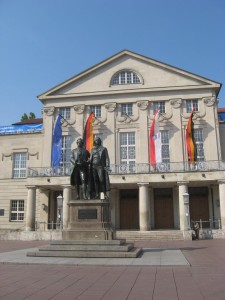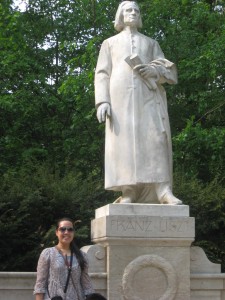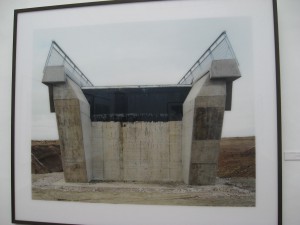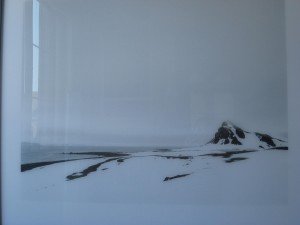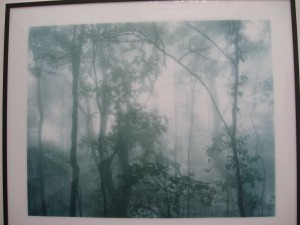Schiller and Goethe- Germany’s most famous bromance pair
Weimar was a surprise trip on many levels for me. My good friend, K, won this trip as the ultimate prize from the Fulbright Conference: lodging for two at the Best Western Inn in the beautiful city of Weimar. The best surprise was K’s invitation in joining her. Who says no to a free trip at a 4-star hotel? (Of course, I was delighted because K’s also a good friend of mine so I’m not entirely greedy, I promise.)
Known for its intimate associations with the renowned writers, Goethe and Schiller, the city was a breath of fresh air for K and me as we decided to take advantage of the last weekend of Easter Break. Another delightful surprise for K and me was the city’s associations with Franz Liszt. Liszt is one of my favorite composers and when we stumbled upon a statue of him, I almost started fan-girling like an idiot teenager in the middle of a park. K graciously took a picture of me with the famous womanizer pianist and composer. Have no idea who Liszt is? Listen to his famous piece, Hungarian Rhapsody. I suggest skipping ahead to the 2:08 mark where I’m sure you’ll recognize the familiar tune. We were happy to find out that 2011 is the year of Liszt in Weimar 😀
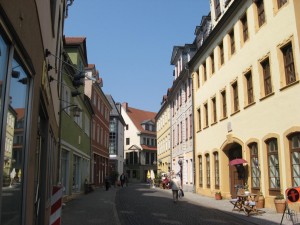 I enjoyed Weimar because of its subtle, international associations that were carefully veiled in the very German streets of the city. I rejoiced at seeing such a typical German city, and yet was pleasantly surprised that there was a street named after Pushkin and another after Abraham Lincoln. Hans Christian Andersen apparently lived in the city for a short amount of time too.
I enjoyed Weimar because of its subtle, international associations that were carefully veiled in the very German streets of the city. I rejoiced at seeing such a typical German city, and yet was pleasantly surprised that there was a street named after Pushkin and another after Abraham Lincoln. Hans Christian Andersen apparently lived in the city for a short amount of time too.
The above picture was taken by the photographer, Hans-Christian Schink, and is part of an exhibition in the Neues Museum in Weimar. That was, hands down, one of the most boring museums I’ve ever been to in my life. The fact that there was only one other woman in the museum besides K and me made it clear that this museum may not be the most beloved in Weimar. We quickly realized the absolute, boring nature of the museum.
Now, I must say that my excitement about Weimar also stems from the fact that I’ve never stayed in Eastern Germany before. I’ve traveled through Eastern Germany but never stopped anywhere (Leipzig and Dresden are still on my list of cities to see in Germany by the way). It is with some irony that this museum was deemed boring by me because it was so deeply Eastern German. What the heck does that mean? [You may skip the rest of this post because it is not politically-correct. What is Germany doing to my American political-correctness machine?]
Reading on, are we? Here’s fair warning: I’ve only taken one semester of art history that did not include Eastern German art. Please take my opinion as purely opinion with no factual base to rely upon. Thank you.
The museum had some interesting pieces but everything reflected something that may be inherently Eastern German in terms of art: unforgiving straight-forwardness. Schink’s photography embodied this as K and I passed through room after room of perfect symmetry, plain finished/unfinished buildings and uncreative perspectives of various landscapes. What was unbelievable to me was that the subjects he chose to weave stories with his photography from were not at all boring. I doubt anyone would say Vietnam or the renovations of Eastern Germany post-reunification are boring. How ‘bout cute penguins in the expanses of the South Pole?
To be fair: Schink’s photographs of a rain forest in Vietnam were not at all boring.
His photography, while precise and crisp, lacked a dynamic aspect that draws me to art: excitement. I appreciated his artistic skills and the obvious concentration and focus he put into these works. I guess I just can’t forgive anyone who managed to make the South Pole boring. I applaud him for doing the unthinkable.
Despite the odd museum, K and I thoroughly enjoyed ourselves in Weimar. The city was gorgeous with its traditional German architecture and I was happy to have finally visited a city in Eastern Germany. I couldn’t have ended my Easter Break on a better note!

